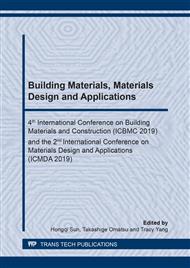p.148
p.159
p.165
p.172
p.178
p.185
p.191
p.203
p.208
Improvement of Poly(Lactic Acid) Properties by Using Acrylonitrile-Butadiene Rubber and Polyethylene-g-Maleic Anhydride
Abstract:
This research prepared poly(lactic acid) (PLA) and PLA/acrylonitrile-butadiene rubber (NBR) blends before and after adding polyethylene-g-maleic anhydride with 3 wt% of maleic anhydride (PE-g-MA3) 3 phr. The effects of NBR and PE-g-MA3 on morphological, mechanical and thermal properties of PLA and PLA blends were discussed. The morphological analysis observed the two-phase morphology of PLA/NBR blends, and it was observed the cavities generated due to NBR phase detachment during sample fracture, and droplets of NBR phase at higher NBR content. The PE-g-MA3 addition could improve adhesion between PLA and NBR phases due to the decrease of cavities in PLA matrix and droplet size of NBR. The mechanical properties showed the impact strength and strain at break of PLA/NBR blends dramatically increased when the amount of NBR increasing. The addition of PE-g-MA3 significantly improved the impact strength of PLA/NBR blends. The thermal properties showed the NBR addition had effect slightly on the melting temperature of PLA/NBR blends. The filling of NBR and PE-g-MA3 greatly decreased the percent crystallinity of PLA more than two times. The thermal degradation of pure PLA and NBR proceeds by one step, while the thermal degradation process of PLA/NBR and PLA/PE-g-MA3 proceeds by two steps. Which the first step showed a large mass loss of PLA degradation and the second step showed a small mass loss of PE-g-MA and NBR degradation.
Info:
Periodical:
Pages:
178-184
Citation:
Online since:
October 2019
Price:
Сopyright:
© 2019 Trans Tech Publications Ltd. All Rights Reserved
Share:
Citation:


